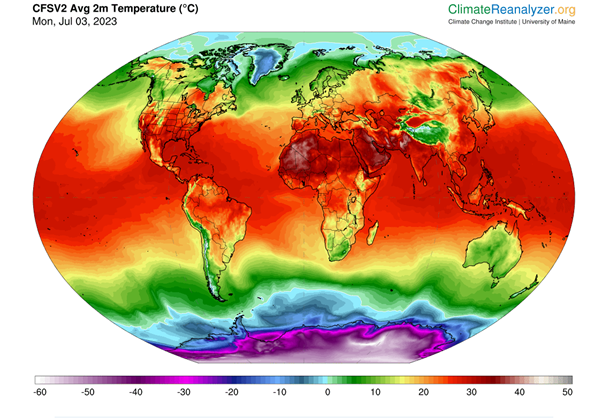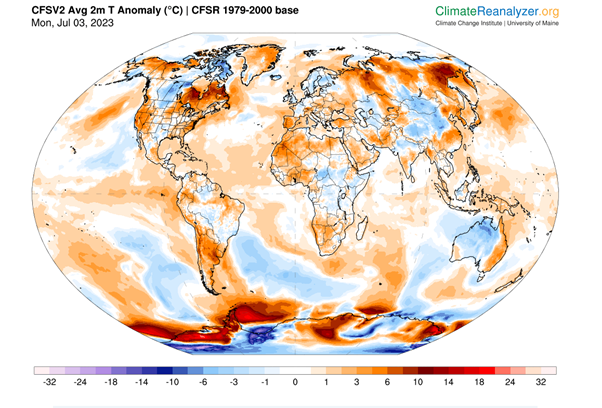Monday, July 3, was the hottest day since measurements began, and almost certainly long before then. The break from the previous record, set seven years ago, was unusually large in a category where advances usually come in hundredths of degrees. Sadly, however, it is very unlikely this record will stand for long, and may even have been broken the following day.
Numerous agencies are reporting US National Centers for Environmental Prediction have announced the global average temperature on July 3 was 17.01°C (62.62°F). The statement is not on their website at the time of writing, but the Climate Reanalyzer website at the University of Maine provides global average temperatures for every day of the last 44 years. Not only does it confirm the reports, it indicates July 4 was hotter still at 17.18°C (62.92°F), although this data is probably still incomplete.
As the map below shows, the heat was most intense across North Africa and Arabia, although with the traditional biases, it’s the southern United States that has been getting the most coverage.

Average 24-hour temperature for July 3, 2023, based on a range of measurements
However, when it comes to temperature anomalies relative to the norm for this time of year, it is the higher latitudes that really contributed to the records. Parts of Antarctica and nearby waters are 17°C (30°F) above normal and the excess is also very large in eastern Canada and parts of Siberia.

Map of global temperature anomalies on July 3 compared to normal for this time of year. Slightly larger anomalies have been observed at other times, such as March 9 this year, relative to a lower baseline temperature
The data is based on a combination of satellite measurements, ground-based weather stations, and air balloon data to estimate the temperature 2 meters (6.6 feet) off the ground. These measuring systems don’t always agree perfectly, and slightly different numbers may emerge once there is more time to incorporate additional sources. However, it is very unlikely any revisions will be substantial.
Seventeen degrees may sound a little on the chilly side, but it includes not only nighttime temperatures, but those from the poles and the half of the planet in the middle of winter. The previous worldwide record was 16.92°C (62.46°F), set in August 2016 and equaled last year.
The Earth is closest to the Sun on January 3, and furthest away in early July, so it’s a little ironic that July-August tends to be the hottest time of the year for the planet as a whole. Water is slow to warm and cool, relative to land. With far greater landmasses in the northern hemisphere, summers there have a bigger impact on global temperatures than when it’s the southern half of the planet’s turn to face the Sun. Combined with the amount of sunlight reflected by Antarctica’s vast ice sheets, the southern summer doesn’t have the same effect.
El Niños move heat around compared to other phases of the ENSO cycle, but on average tend to be hotter than neutral or La Niña years. It’s no coincidence that the previous record was set during the last El Niño, although the fact it was repeated in a La Nina year is particularly disturbing.
However, the world has been in an El Niño in July plenty of times since satellite data became available without getting this hot. Older records show temperatures have not approached this level in the century between weather stations and marine water sampling became global and the launch of weather satellites.
Paleoclimate sources such as tree rings and stalagmites can’t provide day-by-day resolution, but given what we know of background conditions, it’s unlikely the world experienced a day this hot for tens of thousands of years.
“This record breaking hottest day is only one of numerous records we will continue to see broken, in light of our continuing rate of greenhouse gas emissions,” said Professor Kathryn Bowen of the University of Melbourne in a statement. “This latest news points to what we already know – that changes in our climate are going to continue to increase and consequent impacts on our health and wellbeing are central to the fallout.”
Source Link: Monday Was The World's Hottest Day On Record, But Tuesday Probably Beat It